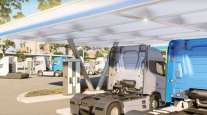Staff Reporter
Electric Truck Market Considers Infrastructure Reality

[Stay on top of transportation news: Get TTNews in your inbox.]
Electric truck market growth is poised to accelerate even as infrastructure constraints hinder that trajectory, according to experts.
“We’ll continue to see a growing demand,” Jared Ruiz, vice president of the west region at Volvo Trucks North America, said. “Obviously, if you look at the total heavy-duty truck market in North America, it’s still a very small percentage today. But it’s definitely growing. I think it’ll continue to escalate upward.”
ACT Research and Rhein Associates said in a joint preliminary report March 8 that battery-electric truck production is expected to triple year-over-year in 2023. MarketsandMarkets said in a report March 23 that the global electric truck market is estimated to grow from 101,499 units in 2022 to 1,067,985 units by 2030 at a compound annual growth rate of 34.2%.
“I think the growth is going to accelerate,” Dan O’Shea, vice president of business development at the electric vehicle charging company ABB E-mobility, said. “We’re anticipating a pretty steep increase in trucks including Class 8 cabs. There are some potential limiting factors, supply chain issues and things like that, the economy. These are things that we can’t really predict.”
ACT Research: Battery Electric Truck Production Expected to Triple in 2023https://t.co/xZUnJ0NqiV — ACT Research (@actresearch) March 8, 2023
The expected increase in electric truck production has coincided with industry groups refocusing their efforts on reducing greenhouse gas emissions. American Trucking Associations announced the launch of the Clean Freight Coalition on March 23. Cummins Inc. launched a new brand called Accelera a couple weeks prior to accelerate the transition to sustainable energy solutions.
“End user are out there and they’re experiencing this technology and they’re understanding the positive impact it can have on their overall operations,” Brian Wilson, general manager of electrified components at Accelera by Cummins, said. “We feel the exact same way that we’re on the precipice of markets starting to turn pretty drastically to battery electric or fuel cell electric technology.”

Joel Morrow of Alpha Drivers Testing & Consulting traveled across America asking one simple question: What if a trucker designed a truck? Hear the program above and at RoadSigns.TTNews.com.
Wilson noted that the launch of the new brand was in part a response to the shifting market. He noted that customers aren’t just interested in the operational benefits of these technologies but also the environmental impact.
“You’ve got a couple different growth curves,” Ruiz said. “You’ve got the demand and I think that’s going to continue to go up pretty steadily and increase faster and faster. I think the actual growth from customer operations is going to be tempered by the charging infrastructure.”
The U.S. signed onto a nonbinding international agreement late last year that aims to make all new medium- and heavy-duty vehicle zero-emission by 2040. But there has been doubt over whether such a goal is realistic. The Truckload Carriers Association pointed out an electric truck that can handle the longhaul segment has yet to be invented.
“These trucks just can’t hold the charge for that long,” Dave Heller, senior vice president of government affairs at TCA, said. “Problem No. 2, obviously, is going to be the availability of charging stations. That becomes problem No. 2 because obviously the infrastructure has yet to be laid out that can really pacify the needs of the industry.”
Heller does still believe the electric truck market will see some gains. But he sees that as catering more to last-mile and regional-haul operations and even then, charging station availability and electrical output will remain issues. O’Shea believes the charging infrastructure will be able to keep up with anticipated growth.

Heller
“We’re not going to lean out too far in production and sales ahead of the availability of vehicles,” O’Shea said. “We’re going to try to work in line with those growth projections. You’ve seen the news about our new factory in South Carolina, which is set to produce 180 kilowatt chargers. These are primarily at this point for the public charging market.”
Ruiz pointed out that carriers must consider whether their utility provider can actually supply them the energy required for the numbers of charging stations they want if they plan to build them on site, as well as software requirements and the type of maintenance work that would need to be done.
“I wouldn’t say it’s just production,” Ruiz said. “It’s the whole infrastructure chain really. All the layers that go into that are going to, I would say, slow the curve comparatively to the demand. I think that’s some of the reality that we’re seeing in the market, on the ground in real life with customers. I think a lot of the customers have much grander goals to move faster. But that’s limiting how fast they can scale up.”
Wilson doesn’t expect the change to happen all overnight. But he believes that for certain operations the time is right to start adopting on a wider scale. He also pointed out there are market and government incentives that are pushing in that direction.
“We’re getting smarter about the designs and the technology required,” Wilson said. “We’re designing better systems, which are more cost-effective systems. In addition, those systems are being further refined for the specific use case in the commercial vehicle market.”
Want more news? Listen to today's daily briefing below or go here for more info:




